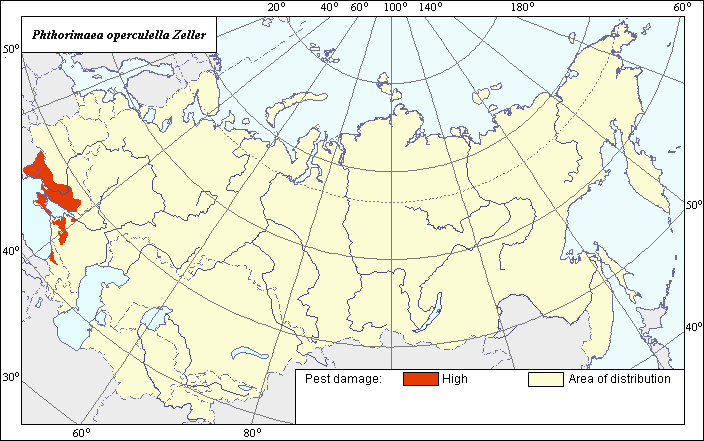Pests
Area of distribution and damage of the Potato Tuber Moth (Phthorimaea operculella Zell.)
 Object description Download GIS-layers
Object description Download GIS-layers
Authors:
Object specialists M.A. Chumakov & T.L. KuznetsovaGIS-specialist M.I. Saulich
Date of creation:
10.09.2005.Scale:
1:20,000,000.Accuracy of map:
Map was created using maps of scale 1:33,000,000.Projection:
"Alber's Equal Area Conic for the USSR", 9, 1001, 7, 100, 0, 44, 68, 0, 0.Basic content:
Vector map consisting of 2 layers. Area of distribution and damage zones are shown by polygons. Single records of species occurrence from Georgia and Russia are shown by points.Accuracy of classifier:
The first outbreak of the Potato Tuber Moth occurred at the Black Sea coast of Georgia in the town of Poti in 1938; within two years, the pest was eliminated. Subsequently, new centers of the pest population were again found in Ukraine (1980) in the Crimea, and then (since 1981) in Russia in the Krasnodar Territory. Now this pest has also been found locally in Moldova and Georgia (Vasyutin et al., 2002). In Ukraine, this species was discovered in the Crimean Republic (including the cities of Alushta, Yalta, and Sevastopol), Kherson, Odessa, Mykolayiv, Zaporizhzhya, Donetsk, and Dnipropetrovsk Regions, with the greatest distribution in the Crimean Republic, Odessa and the Kherson Regions (Omelyuta, ed., 1990; L'vovskiy and Piskunov, 1999). The harm caused by the Moth in field conditions is much less than that in potato storehouses. Since the pest is classified as a quarantine object (Vasyutin, 2000; Vasyutin, 2004), the distribution area directly overlaps the zone of high damage.Mapping procedure:
The map was compiled following an analysis of published data and public maps. Synecological (actual) area (Dedyu, 1990) includes southern regions of Ukraine, Moldova, the Black Sea coast of the Caucasus and most of the Krasnodar Territory. This area and the zone of high damage coincide. They were corrected along areas of industrial potato cultivation and of other solanaceous cultures. Single records of species occurrence from Georgia and Russia in the Rostov Region (Bataisk) are shown by points (L'vovskii and Piskunov, 1999; Vasyutin, 2004). It is necessary to consider the data on moth presence in the Primorskii Territory as indicative of an autoecological, or a potential, area of the species (not shown on map). The registration and vectoring of raster map were performed using standard GIS-technologies.Related references:
Dedyu, I.I. 1990. Ecological encyclopedic dictionary. Kishinev: MSE, 408 p. (in Russian).L.vovskii, A.L. & Piskunov, V.I. 1999. Fam. Gelechiidae - wing-emarginated moths. In: Kuznetsov, V.I., ed. Insects and mites - pests of agricultural crops. Lepidoptera. St. Petersburg: Nauka. V. 3, part 2, p. 46-93 (in Russian).
Omelyuta, V.P., ed. 1990. Revealing of potato tuber moth and its control (recommendations). Authors collective. Moscow: VO Agropromizdat, VASKHNIL, UkrNIIZR. 17 p. (in Russian).
Vasyutin, A.S., ed. 2000. Quarantine phytosanitary state of the Russian Federation for January 1, 2000. Moscow: MSKH RF, 96 p. (in Russian).
Vasyutin, A.S., ed. 2004. Reference-book on quarantine phytosanitary state of the Russian Federation for January 1, 2004. Moscow: MSKH RF, 102 p. (in Russian).
Vasyutin, A.S., Kayumov, M.K., Mal.tsev, V.F. 2002. Quarantine of plants. Moscow, 536 p. (in Russian).

